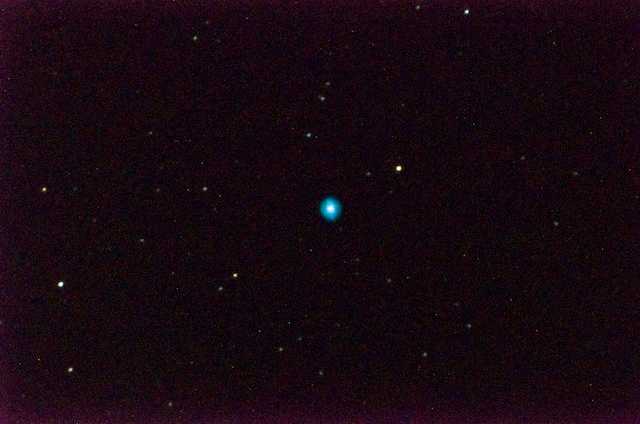
Critters, Saturn Moons, DSOs
Last updated: 28 June 2011![[Home!]](http://www.weasner.com/etx/images/mighty_etx_logo_orig-sm.jpg)
 |
Critters, Saturn Moons, DSOsLast updated: 28 June 2011 |
![[Home!]](http://www.weasner.com/etx/images/mighty_etx_logo_orig-sm.jpg) |
| Follow @mweasner | Welcome | Photos | Videos | Equipment | Links | Data |
On my previous report, I mentioned seeing a quail family from the observatory but I was not able to get a photograph of them. The following morning, as I was preparing that report, another larger quail family appeared outside my window and I did get a photograph:

Saturday, 25 June, the hazy skies from the previous night continued. And clouds appeared. No observing. The clouds remained, and became more numerous, Sunday, 26 June. Maybe the monsoon weather pattern is beginning. We need the rain. Monday, 27 June dawned clear and calm, but the sky turned hazy mid-day, with some clouds appearing mid-afternoon. High temperature was 106°F with a slight breeze. But I decided to open the observatory even with the hazy skies. On the way to the observatory, I saw this rabbit:

The SkyShed POD was opened at 1924 MST, 101°F. I delayed powering on the telescope to let things cool down a little from the day's hot temperature. At 1947 MST, I powered on the telescope and viewed Saturn and Titan at 77X and 133X. At 2001 MST, three more moons became visible at 133X: Rhea, Tethys, and Dione. At 2008 MST, Iapetus was seen at 133X. At 2022 MST, I picked up Enceladus at 133X. A six Saturn moon night!
I set up for iPhone afocal imaging of Saturn's moons. Compare the positions of the moons in this screen capture from SkySafari 3 Pro:

with this cropped image from the Slow Shutter app, 30 seconds, EV+2.0, afocal 26mm + 3X TeleXtender (231X):

The six moons I visually saw are all visible in the image. Enceladus is the most difficult to pick out as it is very close to the overexposed image of Saturn and the Rings.
At 2055 MST, viewed the planetary nebula NGC6826 at 77X. I then began setting up to image it with the D7000 DSLR and 8" LX200-ACF at prime focus + 3X TeleXtender. The nebula was visible in the camera viewfinder. At 2114 MST, took this 30 second, ISO 6400, unguided exposure:

I then did an experiment and tried imaging M57, the Ring Nebula, at prime focus + 3X TeleXtender. However, none of the images were as good as what I had previously done at prime focus alone. I then ended imaging.
At 2150 MST, I began observing some DSOs in the constellation of Draco. Viewed NGC5985 and NGC5982 galaxies. I tried but failed to see NGC5981, another galaxy. All three of these very faint galaxies were discussed in a recent issue of Sky and Telescope magazine. I did view NGC6543, the Cat's Eye Nebula (planetary nebula) at 77X and 133X. Very nice. I tried for NGC4236, a large faint spiral galaxy but could not see it with the 26mm (77X) eyepiece. Switched to the 2" 30mm (67X) eyepiece and was able to see it. It was very diffuse and difficult.
At 2249 MST, I viewed two globular clusters in the constellation of Delphinus: NGC6934 and NGC7006. At 2255 MST, I set up to image these clusters at prime focus. Both of the following images were 30 second exposures, unguided, ISO 6400. The first is NGC6934 (visible in the viewfinder):

And NGC7006 (too faint to be visible in the viewfinder):

I then began waiting for the next imaging target, the M30 globular cluster, to rise above a tree. At 0010 MST, the cluster was just coming out of the tree and was visible in the camera viewfinder. It was still too low for imaging though. Finally, at 0100 MST, M30 was high enough for imaging. This is a 30 second, ISO 6400, unguided exposure:

Closed the observatory at 0115 MST, 82°F. No Kissing Bugs were seen this night. Perhaps the Kissing Bug season is now over.
Go to the previous report.
Return to the Cassiopeia Observatory Welcome Page.